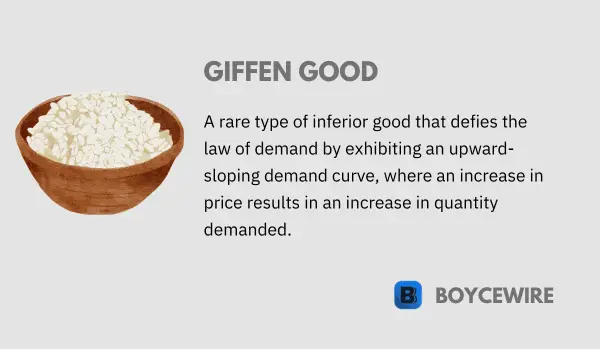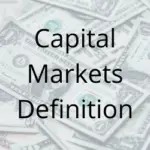Giffen Good: Definition & Examples

What is a Giffen Good?
Giffen goods, named after the Scottish economist Sir Robert Giffen, represent a unique and counterintuitive phenomenon in economic theory. They are a rare type of inferior good that defies the conventional law of demand, which states that as the price of a good increases, the quantity demanded decreases, and vice versa.
However, with Giffen goods, as the price increases, the quantity demanded also increases, resulting in a positive price elasticity of demand. The existence of these goods challenges some of the fundamental assumptions in economics and provides valuable insights into consumer behavior and market dynamics.
Key Points
- Giffen goods are a unique type of inferior goods where an increase in price leads to an increase in quantity demanded, contrary to the law of demand.
- Unlike most inferior goods, which exhibit a negative relationship between price and quantity demanded, Giffen goods show a positive price-demand relationship.
- Giffen goods are often characterized by the absence of close substitutes, representing a significant portion of a consumer’s budget, and being considered a necessity rather than a luxury.
Characteristics and Relationship with Inferior Goods
To understand Giffen goods, it’s essential first to comprehend their relationship with inferior goods. Inferior goods are those for which demand decreases as consumers’ income increases. Essentially, as people’s income rises, they tend to substitute inferior goods with higher-quality, more expensive alternatives.
Giffen goods are a specific subset of inferior goods that exhibit unusual demand behavior. They have three primary characteristics:
- Inferiority They are inferior, meaning that as consumers’ income increases, they prefer to buy less of these goods.
- Lack of close substitutes They typically have limited or no close substitutes available, making it difficult for consumers to replace them even if their price increases.
- Positive price elasticity of demand The key distinguishing feature is that their demand increases when their price rises and decreases when their price falls, in direct contradiction to the law of demand.
The primary reason behind this seemingly irrational behavior is the income effect. When the price of a Giffen good increases, consumers’ real income (purchasing power) decreases, forcing them to cut back on the consumption of more expensive, superior goods. Consequently, they end up consuming even more of the cheaper Giffen good despite its rising price. This outcome is only possible when the income effect is strong enough to outweigh the substitution effect, which would typically lead consumers to buy less of a good as its price increases.
It’s important to note that these goods are extremely rare and mainly theoretical in nature. Identifying them in real-world markets can be challenging, as they require specific conditions to exist.
Real-World Examples of Giffen Goods
Giffen goods are theoretically fascinating but challenging to find in real-world markets. However, a few historical and contemporary examples are often cited:
One of the most cited examples of Giffen goods is the Irish Potato Famine in the 19th century. During the famine, as the price of potatoes increased due to scarcity, poorer Irish families were forced to cut back on more expensive food items and consume even more potatoes to meet their caloric needs. This led to an increase in demand for potatoes despite the rising prices.
A study conducted in the 1990s found that rice in certain regions of China behaved as a Giffen good. As the price of rice increased, low-income households reduced their consumption of more expensive food items like meat, and instead, increased their consumption of rice.
Some economists argue that tortillas could be considered a Giffen good in Mexico, as they are a staple food item with few substitutes. However, this claim is debated, and there isn’t a consensus on whether tortillas truly exhibit Giffen good behavior.
1. Irish Potato Famine
2. Rice in China
3. Tortillas in Mexico
While these examples are often cited as evidence of Giffen goods, it’s important to note that their classification as such is not universally agreed upon. Many economists argue that these cases can be better explained through other economic phenomena or that the observed behavior doesn’t fully align with the theoretical characteristics of Giffen goods. Additionally, some critics point out that empirical evidence supporting the existence of Giffen goods is scarce and often anecdotal.
Overall, the concept of Giffen goods remains an intriguing but controversial topic in economics. Although real-world examples are rare and contested, the study of Giffen goods offers valuable insights into consumer behavior, the income effect, and the limits of conventional economic theories.
The Relevance of Giffen Goods in Modern Economics
Despite the scarcity of real-world examples and ongoing debates, their theoretical importance in modern economics is still significant. Studying Giffen goods helps economists and policymakers understand the complexities of consumer behavior and the potential exceptions to the Law of Demand.
Consumer Behavior
- It challenges the conventional understanding of how consumers react to price changes. By examining the conditions that could potentially lead to Giffen goods, economists can gain a deeper understanding of the factors influencing consumer decision-making and the relationship between income and substitution effects.
Elasticity of Demand
- It highlights the importance of elasticity in determining the demand for a product. Elasticity measures how sensitive the quantity demanded of a good is to a change in its price. Giffen goods, with their positive price elasticity of demand, demonstrate that the relationship between price and quantity demanded is not always straightforward.
Market Interventions
- Understanding Giffen goods can help policymakers and development economists recognize the potential unintended consequences of market interventions. For example, efforts to subsidize or reduce the price of certain staple goods may not always have the desired effect on consumption, particularly in cases where the good in question exhibits Giffen-like behavior.
Income Distribution and Poverty
- Giffen goods are typically associated with inferior goods and low-income populations. By studying the circumstances under which it might emerge, economists can gain insights into the dynamics of income distribution, poverty, and the consumption patterns of disadvantaged groups.
In conclusion, while Giffen goods remain a rare and debated phenomenon, their study continues to contribute valuable insights to the field of economics. By understanding the intricacies of consumer behavior, demand elasticity, and market dynamics, economists can better inform policy decisions and develop effective strategies for addressing economic challenges.
Limitations of Giffen Goods
Although Giffen goods hold theoretical importance in economics, identifying and studying them in real-world situations presents several challenges. The rarity and specific conditions required for the existence of Giffen goods make it difficult for economists to confirm their presence and study their effects.
- Empirical Evidence Empirical evidence for Giffen goods is limited, as they are considered rare exceptions to the Law of Demand. While some studies have provided evidence of Giffen-like behavior, these cases are often contested, and the debate over their existence continues.
- Isolating Factors The presence of multiple factors influencing consumer behavior and market dynamics complicates efforts to identify and study Giffen goods. Isolating the impact of a single factor, such as price changes, can be difficult when considering the complex web of interrelated factors affecting consumption patterns.
- Dynamic Market Conditions Market conditions are constantly evolving, which means that even if a good exhibits Giffen-like behavior at one point in time, it may not continue to do so as economic circumstances change. This makes it challenging to study these goods over extended periods and evaluate their long-term effects on markets and consumers.
- Definition and Classification There is some debate among economists regarding the precise definition and classification. This lack of consensus can make it challenging to identify and study these goods consistently across different markets and contexts.
Despite these challenges, the study of such goods remains an important aspect of economic theory. Understanding the conditions under which Giffen goods may arise and the factors that contribute to their existence can provide valuable insights into the complexities of consumer behavior, market dynamics, and the broader economic landscape.
Giffen Goods and Veblen Goods
Giffen goods and Veblen goods are two unique types of goods that defy the basic laws of demand in economics. While both goods exhibit unusual consumer behavior, the reasons behind their peculiarities are different.
Giffen Goods
These are inferior goods whose demand increases as their price increases, contrary to the typical law of demand. This unusual behavior occurs due to the income effect, which outweighs the substitution effect. When the price of a Giffen good increases, consumers may not be able to afford other, more expensive goods, so they end up consuming more of the Giffen good.
They are usually staple goods, such as rice or bread in low-income households. These goods tend to have few substitutes and are considered necessities. Giffen goods are rare and challenging to identify in real-world scenarios.
Veblen Goods
Veblen goods are luxury items whose demand increases as their price increases, also contrary to the law of demand. This phenomenon occurs due to the goods’ perceived exclusivity, status, and prestige associated with owning them. Consumers believe that higher prices indicate higher quality, and owning such goods signals wealth and social status.
Examples of Veblen goods include luxury cars, designer clothing, high-end jewelry, and expensive wines. The demand for these goods is driven by the “snob effect,” where consumers value the exclusivity and status symbol associated with owning these items.
Key Differences
- Type of Goods Giffen goods are inferior goods, typically considered necessities, while Veblen goods are luxury items with a high degree of exclusivity and prestige.
- Reason for Unusual Behavior The demand for Giffen goods increases with price due to the income effect, while the demand for Veblen goods increases with price due to the perceived value and status associated with the goods.
- Substitutes Giffen goods often have few or no close substitutes, while Veblen goods may have substitutes but are chosen for their exclusivity and social signaling value.
Conclusion
In conclusion, Giffen goods, characterized by their unique demand behavior and seemingly counterintuitive price-consumption relationship, offer valuable insights into the complexities of consumer behavior and market dynamics. While they are relatively rare occurrences in real-world economies, understanding the concept and its implications is crucial for policymakers, businesses, and researchers alike.
By examining the conditions under which they may emerge, as well as their potential applications and policy implications, we can deepen our understanding of consumer behavior and develop more effective strategies in various fields, such as welfare programs, pricing strategies, international trade, macroeconomic policy, and behavioral economics. Although the concept may seem abstract, it contributes significantly to our overall knowledge of economic systems and human decision-making, ultimately leading to better-informed decisions and more effective policies.
FAQs
A Giffen good is a type of inferior good for which the demand increases when its price rises, contrary to the law of demand.
Unlike regular goods, where demand decreases as price increases (adhering to the law of demand), Giffen goods exhibit a positive income effect that outweighs the negative substitution effect, leading to an upward-sloping demand curve.
The unique characteristic of Giffen goods is that they tend to be necessities with no close substitutes and consume a significant portion of the consumer’s income. As their price increases, consumers, particularly those with low income, may have to allocate a larger portion of their budget to the Giffen good, leaving less for other goods, resulting in a higher demand for the Giffen good despite its higher price. gab vac
Giffen goods are relatively rare and are considered exceptions rather than the norm in economic theory. They are more likely to be found in specific contexts where unique conditions, such as extreme poverty, limited substitutes, and certain consumption patterns, exist.
About Paul
Paul Boyce is an economics editor with over 10 years experience in the industry. Currently working as a consultant within the financial services sector, Paul is the CEO and chief editor of BoyceWire. He has written publications for FEE, the Mises Institute, and many others.

Further Reading
 Capital Markets: Definition, Types & Functions - Capital markets are where savers come to invest their capital in long term investments such as corporate debt, equity-backed securities,…
Capital Markets: Definition, Types & Functions - Capital markets are where savers come to invest their capital in long term investments such as corporate debt, equity-backed securities,…  Factors of Production: Definition, 4 Factors & Examples - The factors of production are all the various elements that are required to come together to create a good.
Factors of Production: Definition, 4 Factors & Examples - The factors of production are all the various elements that are required to come together to create a good.  How Does Quantitative Easing Work - Quantitative Easing works in 5 sequential steps: Central Bank Creates Money, Central Bank Purchases Debt, Interest Rates Decline, Businesses/Consumers Borrow…
How Does Quantitative Easing Work - Quantitative Easing works in 5 sequential steps: Central Bank Creates Money, Central Bank Purchases Debt, Interest Rates Decline, Businesses/Consumers Borrow… 